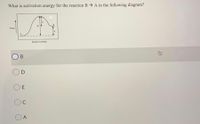
Chemistry
10th Edition
ISBN: 9781305957404
Author: Steven S. Zumdahl, Susan A. Zumdahl, Donald J. DeCoste
Publisher: Cengage Learning
expand_more
expand_more
format_list_bulleted
Question
Can i get help with this problem

Transcribed Image Text:**Question:** What is the activation energy for the reaction B → A in the following diagram?
**Diagram Explanation:**
The diagram is a potential energy graph depicting the energy changes during a chemical reaction. It includes:
- **Y-Axis:** Labeled as Energy.
- **X-Axis:** Labeled as Reaction Coordinate.
- A curve representing the energy changes of the reaction is drawn along the graph.
- Various points labeled A, B, C, D, and E are marked along the energy curve.
- The initial energy level (labeled A) represents the potential energy of reactant B.
- The peak of the curve (labeled D) represents the transition state or the highest energy point of the reaction.
- Points marked on the vertical axis show different energy levels associated with different stages of the reaction.
**Options:**
- ○ B
- ○ D
- ○ E
- ○ C
- ○ A
**Note:**
The activation energy is the energy difference between the reactants and the transition state, typically represented by the difference between A (or a similar point at the reactant level) and the peak, D.
Expert Solution
arrow_forward
Step 1
Activation energy is minimum energy required to take part in the chemical reaction.
Reverse reactiion for B to A C is energy of product and E is activation energy
Correct option is C
Step by stepSolved in 2 steps

Knowledge Booster
Learn more about
Need a deep-dive on the concept behind this application? Look no further. Learn more about this topic, chemistry and related others by exploring similar questions and additional content below.Similar questions
- What are the implications of labeling theory? Give a description of labeling theory and use specific examples to describe implications.arrow_forwardHCl (aq), Zn(Hg) Br2, FeBr3 NBS, light KMnO4, H3O+ Mg metal, ether KOH, EtOH, heat CH3Cl, AlCl3 Dilute H3O+ ClCO(CH2)2CH3, AlCl3 NaCCCH2CH3 HNO3, H2SO4 2-butanonearrow_forwardClassify the following alcohol as primary, secondary, tertiary or quaternary: OH Xon 1⁰ 2⁰ 3⁰ 4⁰arrow_forward
- NaBH4 MEOH (CH3CH2)2NH, mild acid NABH3CN H3CSHarrow_forwardم h) ی ОН CHO- A SOCI Pyridinearrow_forwardFörčé Completion This test can be saved and resumed at any pc Remaining Time: 58 minutes, 20 seconds. Question Completion Status: A Moving to another question will save this response. Question 5 Draw at least 5 isomers for C5H11C1? Attach File Browse My Computer A Moving to another question will save this response.arrow_forward
- Highlight the atoms or groups that are in hydrophilic portions of this molecule in red. If this molecule does not have hydrophilic portions, check the box below the drawing area. CI-CH₂ Cl -CH-CH₂ CI This molecule doesn't have hydrophilic portions. X 000 Ar H ENarrow_forwardCH3 H3C-CH-CH-C-OH Br IUPAC i. CH3 H3C-CH-CH-C-OH Br Common k. Hyc-d-CH,- -C-OH IUPACarrow_forwardPlease help! I need to know how to draw the full chemical structure of isoproyl red. *I drew the structure of isopropyl alcohol (second pic) but was told this was incorrect and that the chemical structure needs to show a combination of methyl red and isopropyl alcohol.arrow_forward
arrow_back_ios
SEE MORE QUESTIONS
arrow_forward_ios
Recommended textbooks for you
 ChemistryChemistryISBN:9781305957404Author:Steven S. Zumdahl, Susan A. Zumdahl, Donald J. DeCostePublisher:Cengage Learning
ChemistryChemistryISBN:9781305957404Author:Steven S. Zumdahl, Susan A. Zumdahl, Donald J. DeCostePublisher:Cengage Learning ChemistryChemistryISBN:9781259911156Author:Raymond Chang Dr., Jason Overby ProfessorPublisher:McGraw-Hill Education
ChemistryChemistryISBN:9781259911156Author:Raymond Chang Dr., Jason Overby ProfessorPublisher:McGraw-Hill Education Principles of Instrumental AnalysisChemistryISBN:9781305577213Author:Douglas A. Skoog, F. James Holler, Stanley R. CrouchPublisher:Cengage Learning
Principles of Instrumental AnalysisChemistryISBN:9781305577213Author:Douglas A. Skoog, F. James Holler, Stanley R. CrouchPublisher:Cengage Learning Organic ChemistryChemistryISBN:9780078021558Author:Janice Gorzynski Smith Dr.Publisher:McGraw-Hill Education
Organic ChemistryChemistryISBN:9780078021558Author:Janice Gorzynski Smith Dr.Publisher:McGraw-Hill Education Chemistry: Principles and ReactionsChemistryISBN:9781305079373Author:William L. Masterton, Cecile N. HurleyPublisher:Cengage Learning
Chemistry: Principles and ReactionsChemistryISBN:9781305079373Author:William L. Masterton, Cecile N. HurleyPublisher:Cengage Learning Elementary Principles of Chemical Processes, Bind...ChemistryISBN:9781118431221Author:Richard M. Felder, Ronald W. Rousseau, Lisa G. BullardPublisher:WILEY
Elementary Principles of Chemical Processes, Bind...ChemistryISBN:9781118431221Author:Richard M. Felder, Ronald W. Rousseau, Lisa G. BullardPublisher:WILEY

Chemistry
Chemistry
ISBN:9781305957404
Author:Steven S. Zumdahl, Susan A. Zumdahl, Donald J. DeCoste
Publisher:Cengage Learning

Chemistry
Chemistry
ISBN:9781259911156
Author:Raymond Chang Dr., Jason Overby Professor
Publisher:McGraw-Hill Education

Principles of Instrumental Analysis
Chemistry
ISBN:9781305577213
Author:Douglas A. Skoog, F. James Holler, Stanley R. Crouch
Publisher:Cengage Learning

Organic Chemistry
Chemistry
ISBN:9780078021558
Author:Janice Gorzynski Smith Dr.
Publisher:McGraw-Hill Education

Chemistry: Principles and Reactions
Chemistry
ISBN:9781305079373
Author:William L. Masterton, Cecile N. Hurley
Publisher:Cengage Learning

Elementary Principles of Chemical Processes, Bind...
Chemistry
ISBN:9781118431221
Author:Richard M. Felder, Ronald W. Rousseau, Lisa G. Bullard
Publisher:WILEY